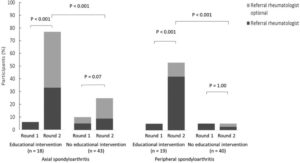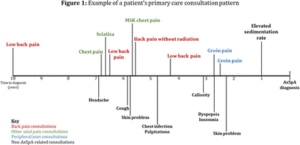
READ HERE
Knowledge of features of inflammatory back pain in primary care in the West Midlands: a cross-sectional survey in the United Kingdom.
Adizie T, Elamanchi S, Prabu A, Pace AV, Laxminarayan R, Barkham N. Knowledge of features of inflammatory back pain in primary care in the West Midlands: a cross-sectional survey in the United Kingdom. Rheumatology International. 2018;38(10):1859-63. https://link.springer.com/article/10.1007%2Fs00296-018-4058-5
Large scale observational study of 141 GPs. Demonstrated a lack of confidence of GPs in differentiating inflammatory back pain, with most (87%) reporting seeing patients 3 times before attempting to make a diagnosis of inflammatory back pain. Just 5% rated themselves as “very confident” at discriminating inflammatory back pain. 64% were not aware of their existing local specialist axial SpA service. Most agreed that inflammatory back pain patients should be referred to a rheumatologist (95%) with a minority suggesting orthopaedics (5%). GPs felt their diagnostic skills could be improved by practical sessions (57%), referral pathways (69%) and electronic updates (24%), with teaching meetings (77%) preferred to digital forms of education (30%).



